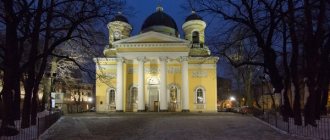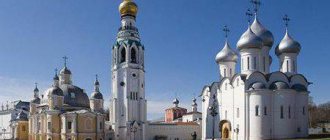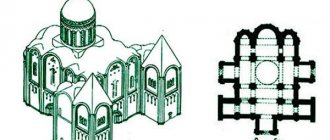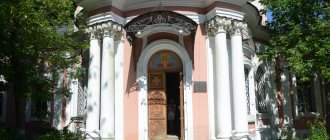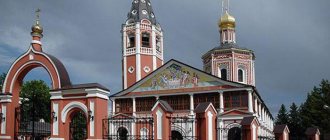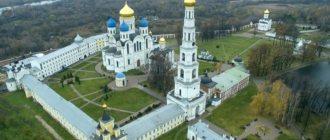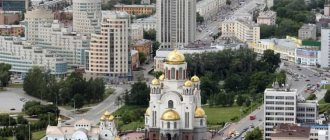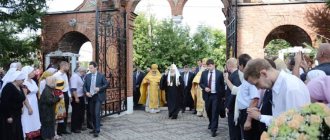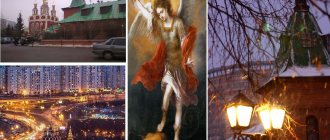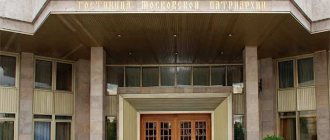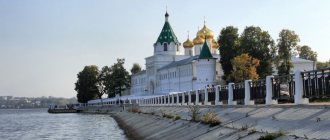The Kazan Cathedral in St. Petersburg is one of the largest operating churches in the city. Its main shrine is the Miraculous Icon, thanks to which the temple received the name Cathedral of the Kazan Icon of the Mother of God.
The parish of the cathedral regularly participates in church holidays and religious processions. Today, on the territory of the church there is a library, an art school, a lecture hall, a Sunday school for children and adults, an Orthodox museum of faith, a youth club, a Victory folk choir and a social department. The cultural and educational center of the Kazan Cathedral in St. Petersburg conducts active educational and missionary activities.
Full information about events and activities on the cathedral website
© Kordian Witek
Story
In 1710, a chapel was built on Nevsky Prospekt next to the wooden hospital building, and later the wooden Church of the Kazan Mother of God. By decree of Empress Anna Ioannovna, the new stone church was founded in September 1733, built according to the design of M. Zemtsov and was named Rodestvensky. A significant decoration of the built church was a multi-tiered bell tower 58 meters high.
List of the Kazan Icon of the Mother of God
On July 2, the Kazan Icon of the Mother of God was transferred here from the Trinity Cathedral. And the Nativity Church began to be called Kazan Church after the name of this icon. Later, the church received the status of a Cathedral, which became the main temple in the Northern capital.
By the end of the 18th century, the building had fallen into disrepair and a decision was made to build a new temple. Paul I wanted the new temple to be similar to St. Peter's Cathedral in Rome and in 1799 a competition was announced for its design.
Memorial plaque “Began 1801 with the permission of Paul I”
Count A.S. Stroganov, whose residence was located near the temple, proposed a project by the young architect A.N. Voronikhin, his former serf. The project of Andrei Nikiforovich Voronikhin was approved. In the presence of Alexander I, a new temple was founded. Count Stroganov became responsible for the construction, which was completed by 1811. And the author of the project A.N. Voronikhin was awarded the Order of Anna, second degree, and a lifelong pension.
Only Russian craftsmen participated in the construction of the temple. The team of masons was led by Samson Sukhanov. Most of the builders were serfs, who gave all their earnings to their owners. They lived first in dugouts outside the city, and then in barracks on Konyushennaya Square. Domestic materials were used to decorate the temple: Olonets marble, Vyborg and Serdobol granite, Riga limestone. The external cladding of the walls is made of Pudozh stone, which was brought from Gatchina.
Architectural appearance of the temple
By the will of Paul I, the external appearance of the cathedral was designed to be similar to the Roman Catholic Church of St. Peter in the Vatican. Therefore, the Kazan Church has a number of features that are unusual in the architectural styles of Orthodox cathedrals of that time: the presence of a colonnade on the outside and only one dome. The Cathedral is a grandiose creation of human hands, striking with its external and internal decoration.
The Kazan Cathedral was erected in the French imperial Empire style; the architect Voronikhin and the sculptor Gordeev, together with other outstanding artists of the nineteenth century, worked hard on the basilica form of the temple and the sculptures richly decorating the cathedral.
Relief works crown the outside of the Kazan Cathedral - sculptor Pimenov, in tandem with other talented artists, created beautiful bronze sculptures of great saints. The St. Petersburg Cathedral is the first church in the Russian Empire created in the European style by a Russian architect.
Colonnade
A.N. Voronikhin solved the main problem. Since there should be an entrance in the west of the temple and an altar in the east, the temple turned out to be sideways to Nevsky Prospekt. According to the architect's decision, a grandiose colonnade of 96 columns 13 meters high, made in the form of a semicircle, was erected in front of the northern facade.
Colonnade
Colonnade
Columns
The northern part of the temple, facing Nevsky Prospect, became the front part, decorating the main thoroughfare of the city - Nevsky Prospekt. The temple project was not fully realized. According to the plan, the colonnade should have been on both sides: on the south and on the north. But only the northern colonnade was built. In front of the western, main entrance to the cathedral, the side porticoes of both colonnades were to be connected by a fence surrounding the square.
Excursions
The Kazan Cathedral has a tour service every day from 11.30 to 18.00. Here you can book an individual or group excursion, with an audio guide or a guide. Private tours are available when there are no religious services taking place. All excursions must be booked in advance.
The cathedral also has a pilgrimage service that organizes spiritual, educational and educational trips to the holy places of Russia and Europe. Routes and programs are updated regularly.
Information about pilgrimage tours on the Kazan Cathedral website
© Kazan Cathedral VKontakte
Decoration
At the northern façade of the Kazan Cathedral you can see four bronze sculptures: Prince Vladimir (sculptor S. Pimenov), Andrew the First-Called (V.I. Demut-Malinovsky), John the Baptist (I.P. Martos) and Alexander Nevsky (S. Pimenov).
Sculpture of St. Andrew the First-Called
Sculpture of Prince Vladimir
The bronze entrance doors on the north side of the building are a copy of the doors of the baptismal house in Florence. They were cast and minted by Vasily Ekimov.
Cast iron doors
The architect's plans for the external sculptural design were also not fully realized. On stone pedestals on both sides of the colonnade there were supposed to be sculptures of the archangels Michael and Gabriel.
Interior
The interior of the temple resembles a huge palace hall. Rows of tall granite columns unite the space of the hall. The light pouring from the windows gives the impression that the dome is floating at a great height.
Dome
The icons for the temple were painted by V. Borovikovsky, O. Kiprensky, A. Ivanov and other famous artists. In 1899–1900, a park was built in front of the temple.
Fountain in the park
Helpful information
Kazan Cathedral: opening hours from 7:00 to 20:00
Every day services are held in the cathedral church. Admission is free.
Opening hours and service schedule:
- On weekdays, holidays and Sundays, the Liturgy is served at seven and ten o'clock in the morning; evening service - at six o'clock in the afternoon.
- The cathedral is open every day from 7 am, on Sundays and holidays - from half past seven in the morning. After the evening service ends, the cathedral closes.
- Church Sacraments and short services are performed in the church: memorial services and prayer singing, and a clergyman is constantly present.
Monuments to M.B. Barclay de Tolly and M.I. Kutuzov at the Kazan Cathedral in St. Petersburg
All important events in the history of Russia were connected with the temple. From here, after a solemn prayer service, Field Marshal M.I. left for the active army. Kutuzov. And here in June 1813 the ashes of the great commander were delivered. Kutuzov's body was buried in a crypt built in the northern aisle of the temple.
Burial of Field Marshal M.I. Kutuzova
Captured banners and keys to cities that surrendered to the Russian army were placed nearby.
Trophy French banners
Monuments to M.I. Kutuzov and M.B. Barclay de Tolly organically fit into the architectural and sculptural ensemble of the temple. The figures of the commanders were cast from bronze according to the models of the sculptor B.I. Orlovsky.
Monument to M.B. Barclay de Tolly
The monuments are identical: the commanders are depicted at full height, with cloaks thrown over their shoulders. But if the figure of Barclay is depicted waiting, then Kutuzov seems to be giving a signal to his troops to attack.
Monument to M.I. Kutuzov
Shrines, relics
Kutuzov's grave
Miraculous icon
The main shrine of the temple is the Miraculous Icon, it was found in Kazan in 1579. Twenty-five years after the capture of Kazan by Ivan the Terrible, the city suffered from a fire. The house of the archer Onuchin also burned to the ground. His eight-year-old daughter Matryona saw the Mother of God in a dream, saying that Her miraculous icon was in the ground under the ruins of a burnt house. The girl herself took out the icon, which shone with new colors. Most likely, this icon was buried in the ground during the time of the Tatars, or by one of the Russian captives, or by Muslims who converted to Orthodoxy. Miracles began to happen at the icon. At the place where it was discovered, a monastery was later built.
Other venerated images are not currently in the cathedral:
- Icon of the Savior in the iconostasis.
- Icons of St. Nicholas the Wonderworker and the Mother of God of Czestochowa, donated by M. I. Kutuzov.
- Golgotha with a particle of the Life-Giving Tomb, built according to the design of N. N. Nikonov in 1891.
- Icon of the Resurrection of Christ, also with a piece of the Holy Sepulcher, sent in 1906 by Damian, Patriarch of Jerusalem.
Services in the Kazan Cathedral in St. Petersburg
After the 1917 revolution, the cross was removed from the dome, a gilded ball with a spire was installed in its place, and then a museum of the history of religion was opened here. The icon of the Kazan Mother of God was transferred to the Prince Vladimir Cathedral.
During the siege of Leningrad, several shells hit the building. At the end of the war, a major overhaul was carried out, and then restoration of the interiors of the temple.
Main iconostasis
Since 1991, the Kazan Cathedral has been open for worship again. The Kazan Icon of the Mother of God returned to the temple, and later a golden cross reappeared on the dome. For the 300th anniversary of St. Petersburg, in 2003, craftsmen from the Baltic Plant cast the largest bell for the temple, weighing four tons and more than two meters high. The cathedral often hosts church services with the participation of the highest ranks of the Orthodox hierarchy.
The image of the Holy Shroud is a copy of the Shroud of Turin
Every year on September 12, religious processions are held from the temple along Nevsky Prospect to the Alexander Nevsky Lavra in honor of the prince, the patron saint of the city, Alexander Nevsky.
Schedule of services
Divine services in the cathedral are held daily. During the day, the Sacraments of baptism and wedding, prayer services and memorial services are performed.
- 07.00 - early Divine Liturgy, confession begins at 07.00;
- 10.00 - late Divine Liturgy, confession begins at 09.30;
- 18.00 - evening service.
Schedule of services for 2022 on the official website
© Marat Safiyulin
Abbots
Rectors of the cathedral throughout history Dates Rector Church of the Nativity of the Blessed Virgin Mary 1763-1798 (?) Archpriest Jacob Navrodsky (1731-1798) ...-1803-1809 (?) Archpriest Feodor Vasilyevich Semivsky (1731-1809) Kazan Cathedral 1814-1831 (?) Archpriest Ivan Ivanovich Bedrinsky (1769-1831) 1831-1846 Archpriest Pyotr Nikolaevich Myslovsky (1776 or 1777-1846) 1846-1848 Archpriest Timofey Ferapontovich Nikolsky (1788-1848) 1848-1860 Archpriest Andrei Ivanovich Raikovsky (1 802—1860) 1860—14 (26) June 1881 Archpriest Grigory Sergeevich Debolsky (1808-1881) 1881-28 December 1883 (9 January 1884) Archpriest Alexander Petrovich Bulgakov (1823-1883) 1884-23 March (4 April) 1898 Archpriest Alexander Alekseevich Lebedev (1833-1898) ) 1898-26 November (9 December) 1904 Archpriest Evgraf Ivanovich Megorsky (1838-1904) 1904-26 January (8 February) 1909 Archpriest Dimitry Timofeevich Megorsky (1841-1909) 1909-1913 Archpriest Nikolai Adrianovich Sosnyakov (1845-1913) 19 13 -October 6 (19), 1913 Archpriest Nikolai Nikolaevich Golovin October 10 (23), 1913—arrested August 9, 1918 Archpriest Philosopher Nikolaevich Ornatsky (1860-1918) 1919-1920 Archpriest Vasily Marenin December 1920—arrested May 30, 1922 Archpriest Nikolai Kirillovich Chukov (1 870 -1955) June 1922—March 12, 1923 Archpriest Vasily Anikitich Prozorov March 12—September 17, 1923 “Archpriest” Lev Mikhailovich Teodorovich (1867—after 1930) September—November 25, 1923 “Archbishop” Artemy (Ilyinsky) November 25, 1923—January 17, 1925 “protopresbyter” Vladimir Dmitrievich Krasnitsky January 20, 1925—June 1927 “metropolitan” Veniamin (Muratovsky) (1855—1930) June 1927—January 1932 “metropolitan” Seraphim (Ruzhentsov) (1876—1935) period of closure 1996—present Archpriest Pavel Grigorievich Krasnotsvetov (b. in 1932)
Where is
You can find this attraction at the address: St. Petersburg, on Kazanskaya Square, house No. 2. It is located near the Griboyedov Canal, surrounded on one side by Nevsky Prospect, and on the other by Voronikhinsky Square. Kazanskaya Street is located nearby. There is a metro station "Gostiny Dvor" within a 5-minute walk. The most interesting view of the cathedral opens from the Terrace restaurant; from here it looks like the picture.
Opinions
In the era of Nicholas I, when there was a turn in Russian architecture from copying Western models to an eclectic reworking of the pre-Petrine tradition (the work of K. Ton), the Kazan Cathedral began to be perceived as the beginning of the line that would lead to the “Catholic-Masonic” project of the Cathedral of Christ the Savior, developed by A. Vitberg and rejected by the emperor. The statement of F. Wiegel is characteristic: “Voronikhin, assigned by nature to the shoemaker’s craft, became an architect through teaching; and he, on the recommendation of his master, built the Kazan Cathedral, this copyist in architecture, who could do nothing but rewrite Michelangelo for us in the worst handwriting” (a hint of borrowing the plan of the main temple of Catholicism). At the beginning of the 20th century, with the return of interest in classicism, the “rehabilitation” of Voronikhin’s project took place. In a poem from the collection “Stone” (1913), Osip Mandelstam compared the Kazan Cathedral with a “light spider cross”: “And the architect was not Italian, But Russian in Rome - well, so what! Every time, like a foreigner, you walk through a grove of porticoes.”
